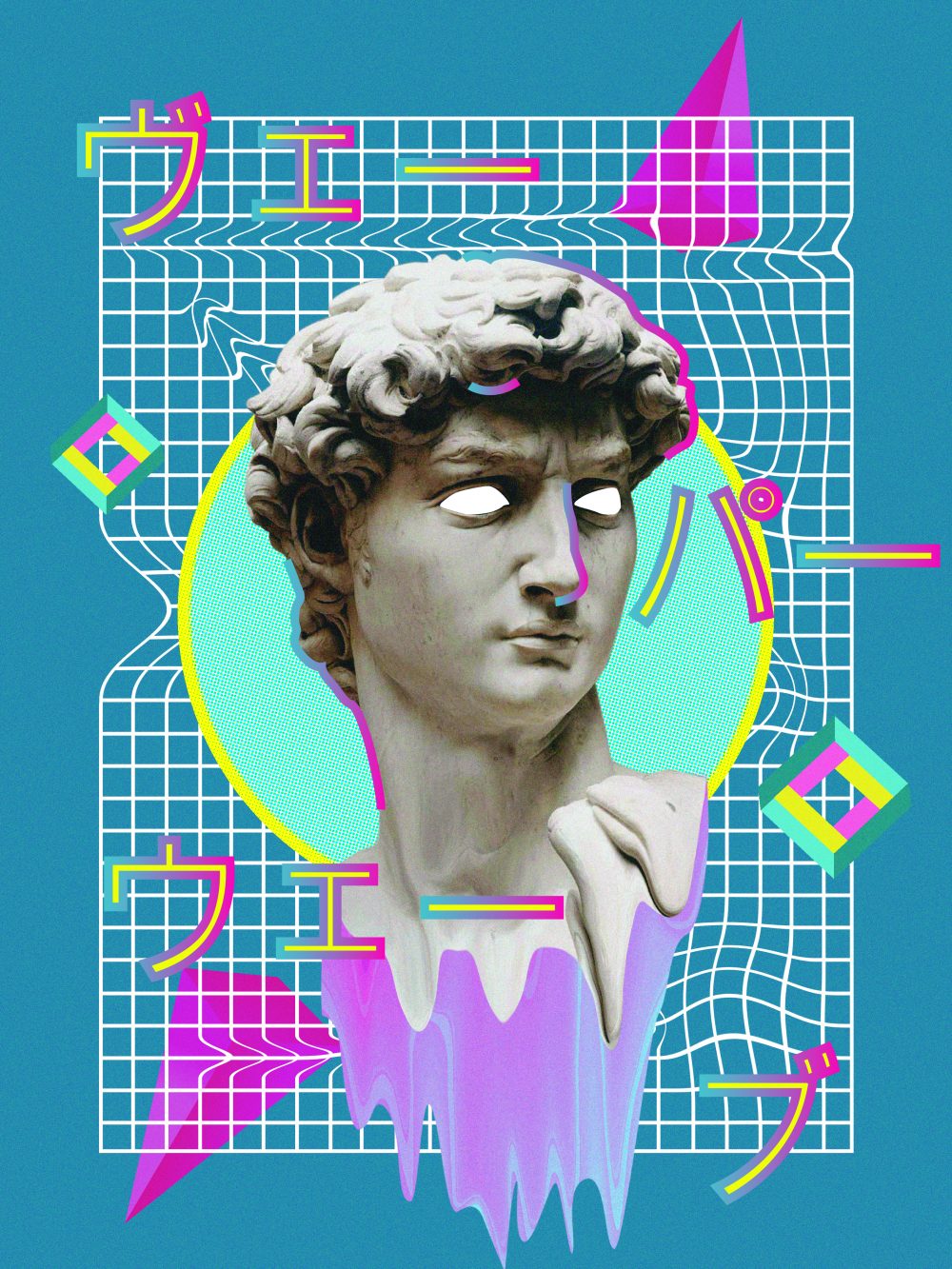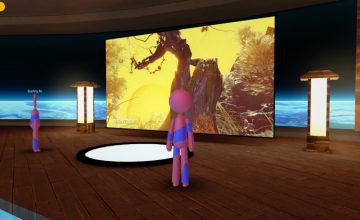It’s 10 p.m. on a weeknight, and I’m in front of a bright 17-inch monitor, inside a crowded cybercafé or internet café or whatever you want to call it. Beside me are a group of college students playing—what else in a cybercafé with a higher than average internet connection speed—computer games. Me? I admit I played a game or two of Dota 2. But it’s 10 p.m., and it’s time to watch a concert.
I make my way to a video streaming website I’ve never visited before. Live video feeds of people streaming whatever they want to stream—mostly people just talking from the looks of it. A bit sketchy, I know, but this one feed I’m looking at in particular is a live performance that’s supposed to be live at this hour. I wait for a few minutes, looking at the pitch black screen of the live feed, and in that feed a projection is cast on the wall on the background. It’s Ghost in the Shell. A figure stands in front of the projection, becoming a mere silhouette in the process, and in front of him is a laptop and music equipment. The figure starts fiddling with the laptop, and the music plays—something that oddly resembles a VST & Co. song.
I blink. The feed is grainy to say the least, but the music is clear. How do I get to describe the music? Have you been to the weird part of Youtube? You know what I mean: artists and song titles you’ve never heard of, with the preview photo a still from some obscure anime or maybe some weird collage of seemingly random objects. There’s a video of a Justin Bieber song slowed down 800%. The music is like that, but easier to listen to. And imagine again, a figure (whose artist name is Sarsi Cuneta, go figure) shadowed by Ghost in the Shell playing on his body, playing this chopped and screwed, slowed down music over a live feed. That’s a e s t h e t i c right there—“a e s t h e t i c” becoming the word being used as a stamp of approval from the fans of Vaporwave. Well, it’s become more like a meme than a compliment really—overused and seen on everything somehow related to vaporwave.
What’s vaporwave anyway? And for a genre that’s been proclaimed dead by the likes of Vice and Reddit, how come a mixtape of vaporwave music from the Philippines emerged Christmas day of 2015? First off, to describe vaporwave: a stylistic convention that appears in both sound and sight. Roman busts, Japanese culture in all its color-drenched appeal, corporate and consumer ads of past decades, and 90s janky internet art all mixed into one big, beautiful smorgasbord. For the music, it’s slowed down, regurgitated smooth jazz, funk, and 80s pop, with a reverb. The most popular song, “恰奏’”菄峆釩颿‘怠〞”or “Computing of Lisa Frank 420 / contemporary” has cover art that is just that, and samples Diana Ross’s “It’s Your Move.” It’s as ridiculous as it sounds.
(Forgive me, music snobs, if I’m describing vaporwave in broad strokes. The thing is, I can’t keep track of all the goddamn genres popping up everywhere: seapunk, witch house, hypnagogic pop, mallsoft. I really can’t. At this point, does it even matter if I call it a different thing? I bet you know what I’m talking about anyway.)
I’m aware it’s so ridiculous. But somehow, some way, it’s so attractive. This mish-mash of corporate ads, this concept of a “virtual plaza” where vaporwave is the elevator music. The music world isn’t really shaken up, but it has got eyebrows raised and heads turned. Critical analysis points to an anti-capitalist movement, of how, by using the detritus of corporate culture, it’s a commentary of how alienated we are defined by the products we buy and the brands we are loyal to. Through these artists who regularly change monikers and play with corporate stock music to the point of defamiliarization, the music becomes a way of solid becoming vapor.
But, taking a step back, the whole premise then sounds too pretentious. Music producer Aaron David Ross puts it well: “This was one of the first of these musical movements to integrate a meaningful sampling of corporate/commercial aesthetics. It initiates a lot of important conversations about power and money in the industry. Or… everything just sounds good slowed down with reverb?”
I don’t know exactly how I got to see the local vaporwave Facebook group, but I immediately joined it. In the coming months, more and more people joined. It’s kind of glad to see people in your country who listen to the same weird shit as you do. And let alone produce. Sometime after the group opened, the group’s founders, Zom Kashwak and Tomi Uysingco, posted their vaporwave music, and the members did so too.
Vaporwave art of local spaces and icons are shared almost daily. And the songs keep flowing. One particular song that samples Kim Chiu’s “Mr. Right,” is very memorable. And it all seems so ironic.
“The netlabel I’ve been running for quite a while now just dropped a GBFCEO x sarsi split, plus 表罔虎玫 ㄡㄢㄟ’s single ‘’we released was suddenly a semi-viral hit,” Tomi (a.k.a. G a r r e t B o b b y F e r g u s o n) explains. “Then these kids, young producers, were suddenly coming out of woodwork, happy in finding out that we were all hyperaware of being part of some sort of massive in-joke, all the while others kept on confusing vaporwave as some meme (which it sorta is, I suppose). So yeah, we just thought, strike while the iron is hot.”
As to why vaporwave and why now, Sarsi replies dryly. “I don’t know, but [vaporwave] was dead a long time ago. Even now, vaporwave is dead. But people visit the dead, right? And I feel after a few years, the same thing happens, people will look back and appreciate even though the hype isn’t as big as before. It happens to all genres. That’s life. Just enjoy. There’s no such thing as forever.”
The Virtual Barangay is an extension of the concept of the Virtual Plaza, a cosmopolitan utopian space where vaporwave plays freely. But the difference is, unlike the virtual plaza who has no inhabitants, the virtual barangay isn’t a commercial space but a residential one. Sarsi Cuneta can dance along to her tunes all day while the music plays.
When I listen to vaporwave, it can either make me break into a little existential crisis or go to sleep. It’s trippy, but it also gives you some insight when you think about it critically. I’m just happy some people listen to the same music I do. And sad too—vaporwave, and music in general, can be so emotional. “Music is not fun, man,” quips Tomi. He’s right. Emotional music accentuates whatever I’m feeling to greater heights or lows. I don’t pretend to enjoy vaporwave as much as I don’t pretend to enjoy music that suits how I feel. I don’t know how to exactly describe what I feel when I listen to vaporwave—listening to new music makes me want to smoke a cigarette and cry in bed and feel the wind on my face in a motorcycle and dance at the same time. But vaporwave has this certain appeal that just gets me. Down to the core the weirdness of it all is just another layer to something that I happen to really enjoy.
Sooner or later, the memes will be run down to the ground and the music will stop. Vaporwave as a genre will fade, swallowed by the entropy of its endless loops. The consumption of what was once unknown has made it enter into the consciousness of the public—the likes of MTV and Tumblr consuming its appeal by adopting a 90s inspired look in their latest rebrands. Vaporwave is what it is and what it’s supposed to be: vapor, slowly dissolving into the air.
Edited for Web. Originally published on our March 2016 issue.
Illustration by Edward Joson

























Comments